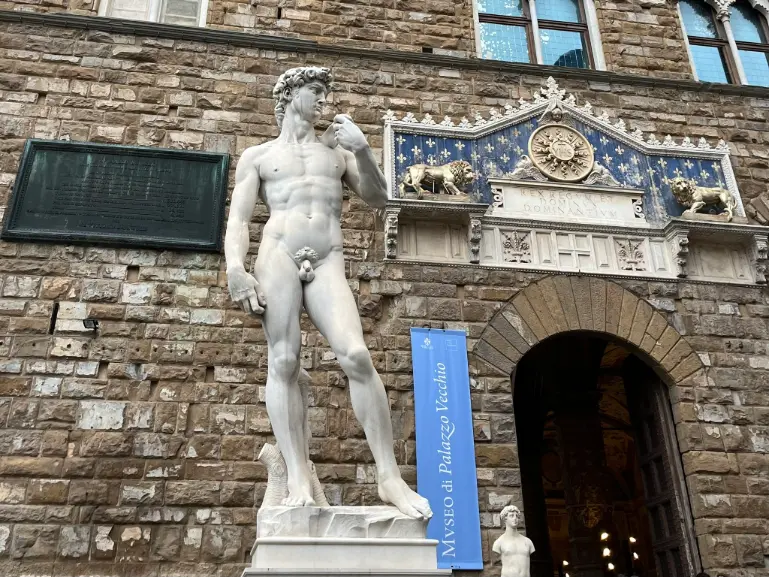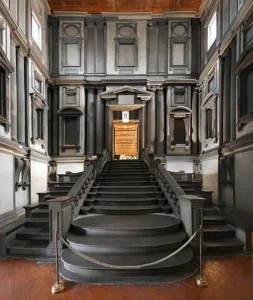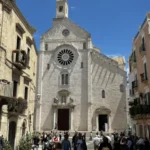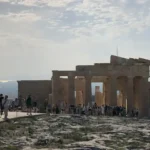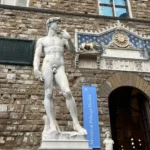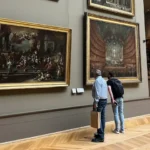Michelangelo in Florence isn’t just a piece of history—it’s something you can still see and feel throughout the city. From world-famous sculptures to quiet chapels, his work is everywhere. If you’re visiting Florence and love art, following Michelangelo’s trail is one of the most rewarding ways to experience the city and connect with its Renaissance roots.
I’ve had the chance to explore Florence a couple of times, and each visit has deepened my appreciation for how deeply Michelangelo is woven into the city’s soul. It’s one thing to admire his genius in books, but it’s something else entirely to stand in front of his work—whether it’s a towering masterpiece or a detail hidden in a side chapel.
So let’s take a closer look at some of the most iconic spots where you can experience Michelangelo’s genius up close—and see how his art helped shape not only Florence, but the course of art history itself.
The Academy Gallery: Michelangelo’s David – A Masterpiece in Marble
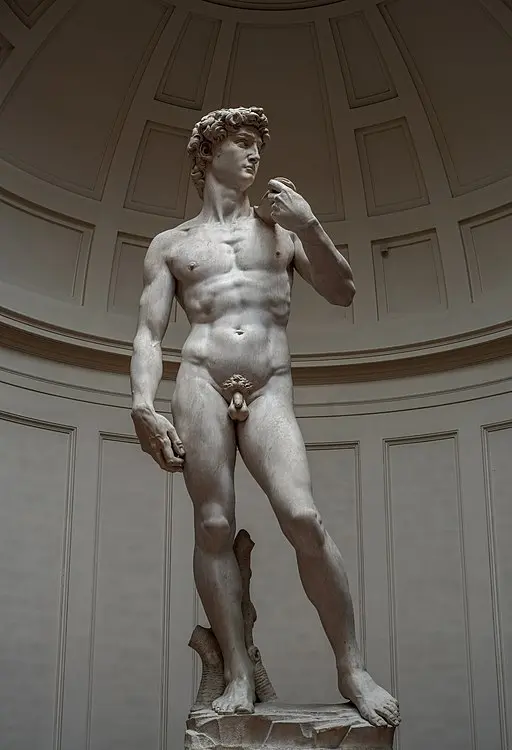
The Academy Gallery is perhaps the most iconic place to experience Michelangelo in Florence, especially through his masterpiece, David. David is not just a statue—it is a symbol of Florence’s strength, resilience, and intellectual power. When you stand before David, it’s impossible not to be in awe of the sheer scale and emotional intensity of the figure. Carved from a single block of marble, the statue stands 14 feet tall, and it was Michelangelo’s vision that brought this monumental figure to life. But David is not simply about size; it’s about the human form in its purest, most powerful sense.
Michelangelo’s David is not shown at the moment of victory, but rather in the moment just before he faces Goliath. There is a sense of stillness and tension in the figure, with every muscle, vein, and tendon perfectly sculpted to convey David’s strength and determination. His body is poised for action, but his face remains calm, almost contemplative, reflecting the intellectual approach to the battle ahead. What Michelangelo captured so brilliantly is the inner tension of the figure: the physical readiness for combat combined with the calm of a mind focused and resolute.
What also sets David apart is how Michelangelo chose to depict him in youthful nudity—a decision that was radical at the time. David’s nude body was not meant to be a purely sensual form, but rather a depiction of human beauty and virility. Michelangelo used contrapposto, a classical technique that gives the body a sense of life and movement. This stance is subtly designed to make David appear like he’s in the middle of a tense moment, waiting for the conflict to unfold. This youthful, unarmed hero was an ideal symbol for Florence, a city constantly facing the threat of larger powers.
Tips from Artsy Trips. Michelangelo’s David was originally intended for the Cathedral facade, but as noted by the Academy Gallery, a panel of artists—including Leonardo da Vinci and Botticelli—chose to place it in front of Palazzo Vecchio in 1504, as a symbol of Florence’s strength. Parts of the statue were once gilded, including the sling and tree trunk.Today, the original is safely housed in the Academy Gallery, and to avoid long waits, it’s smart to book a skip-the-line ticket in advance. It’ll save you time and let you focus on what really matters—standing face-to-face with one of the greatest sculptures in history. If you miss the museum, you can still see a full-size replica in the square.
In addition to David, the Academy Gallery houses Michelangelo’s unfinished sculptures, called the Prisoners or Slaves. These figures were intended for the tomb of Pope Julius II, and the fact that they are unfinished gives them an extraordinary sense of rawness and emotion. They seem to be struggling to emerge from the stone, with their bodies still trapped within their blocks. These works show us Michelangelo’s creative process, where the figure is not fully realized, and yet there is so much life and movement contained within the marble. The Prisoners evoke a sense of human struggle, both physical and emotional, which adds another layer to Michelangelo’s work, revealing his fascination with the tension between freedom and confinement.
The Medici Chapels: Michelangelo’s Mastery in Marble
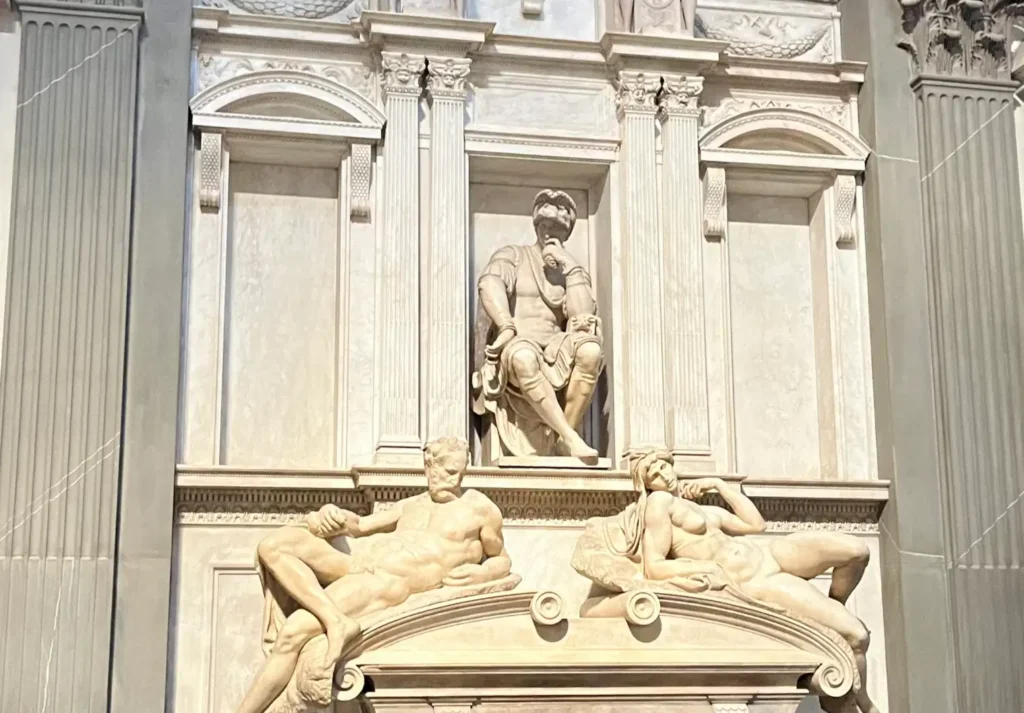
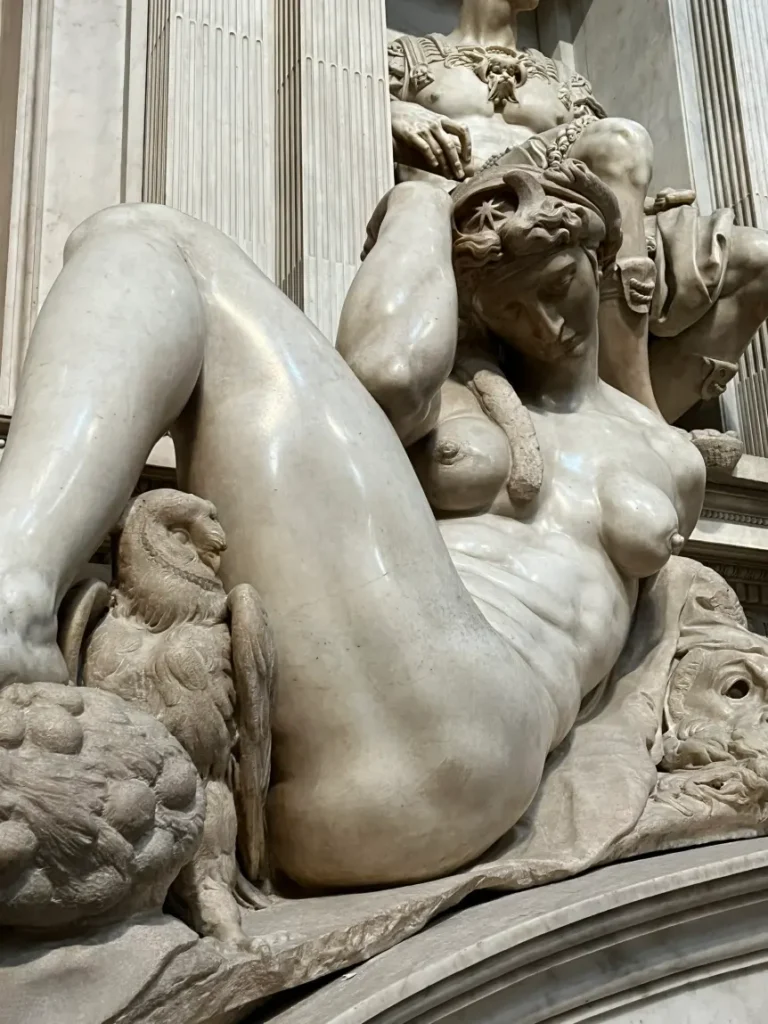
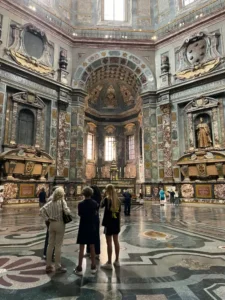
The Medici Chapels at San Lorenzo are essential to any journey tracing Michelangelo in Florence, showing how he blended sculpture and architecture into a single artistic vision. It might sound a bit unexpected, but this is actually my favorite art spot in the city—there’s something about the space that always leaves me completely mesmerized.
The Medici family, Florence’s most influential dynasty, commissioned Michelangelo to design their tombs, and the Medici Chapels are where some of his most profound works are housed. The Tombs of Lorenzo de’ Medici and Giuliano de’ Medici stand as towering achievements in Renaissance art, combining symbolic representations of life, death, and the eternal in the form of Michelangelo’s sculptures.
Within the Medici Chapels, Michelangelo sculpted four figures: Day, Night, Dawn, and Dusk. These allegorical figures are not just representations of time—they are deeply human, full of emotion, and embody universal themes. Take Night, for example (the middle photo). This figure lies half-reclined, draped in flowing fabric. Her expression is one of deep introspection, almost as though she’s lost in thought. Night’s face conveys a sense of melancholy, yet there’s a quiet dignity in her pose. Michelangelo captured the complexity of emotions within a single stone figure, showing the passage of time not just as a physical experience, but as a deeply emotional and spiritual journey.
Complementing these allegorical figures are Michelangelo’s sculptures of Giuliano and Lorenzo de’ Medici, positioned above their tombs, these are not realistic portraits, but idealized figures shaped by Michelangelo’s artistic vision. Giuliano is rendered with poised elegance, his posture upright, his gaze directed outward, radiating calm authority. Lorenzo, by contrast, is deeply contemplative, his figure cloaked in shadow, with a hand supporting his chin—a pose that conveys inward reflection. Michelangelo wasn’t concerned with physical likeness; instead, he sculpted them as timeless archetypes of active and meditative life. Their stylized features and thoughtful compositions turn the tombs into philosophical statements carved in stone.
Tips from Artsy Trips. The first time I tried to visit the Medici Chapels, I bought a ticket to the Basilica of San Lorenzo, thinking it would include both the church and the chapels—since the chapels are technically part of the basilica complex. However, the Medici Chapels have a separate entrance and require a separate ticket. So, if you’re only interested in visiting the Medici Chapels, make sure to walk around the San Lorenzo church and buy a dedicated ticket for the chapels (€9.00).
These monumental sculptures stand in a chapel that was designed by Michelangelo himself, and walking through the space, it’s easy to see how his architectural vision complements his sculptures. The space feels both monumental and intimate, with the tombs commanding attention while maintaining an atmosphere of solemnity and reverence. For me, the Medici Chapels are a place where the full range of Michelangelo’s genius is on display—not just his mastery of the human form in marble, but his ability to weave emotional depth and philosophical reflection into his art.
When visiting the Chapels, don’t miss the chance to step into the Chapel of the Princes (the third photo) —once you enter, you’ll understand why it might be the most impressive chapel you’ve ever seen. I don’t want to exaggerate, but the place is truly spectacular. Interestingly, it wasn’t designed by Michelangelo but by architect Matteo Nigetti. What really makes the Chapel stand out is the sheer richness of the materials. As The Museums of Florence notes, the walls are covered in colorful marbles and rare semi-precious stones—lapis lazuli, jasper, and more—that were incredibly expensive and difficult to obtain. The intricate inlay work took centuries to complete. The result is more than just a tomb—it’s a showcase of wealth, power, and obsessive craftsmanship.
San Lorenzo: Michelangelo’s Library and Architectural Genius
San Lorenzo is one of Florence’s most important churches, but it is also home to another of Michelangelo’s masterpieces—the Medici Library (also known as Laurentian Library), a structure that represents his early foray into architectural design. The library’s staircase is often cited as one of his most innovative contributions to architecture. It’s not just a staircase—it’s a dynamic sculpture in itself. The way the steps curve upward, leading the eye toward the light, creates a sense of openness and movement that is unlike anything in Renaissance architecture. The design guides you, almost like an invisible hand, up to the library itself, evoking a sense of intellectual and spiritual ascent.
The space feels both grand and surprisingly personal, striking a balance between function and beauty. As you walk up the stairs, there’s this quiet sense of transition—from the everyday to something higher, more thoughtful. Michelangelo’s use of light and shadow gives the architecture a sense of movement, almost like the building is alive and breathing. It’s the kind of place that makes you slow down and reflect—where even the walls and staircases seem to guide you toward something deeper.
What’s really interesting about the Medici Library is that it wasn’t just built to hold books—it was designed to reflect the Medici family’s values: their love of knowledge, humanism, and the power of ideas. Michelangelo didn’t just create a functional space; he turned it into a work of art. It shows just how versatile he was—not only a master sculptor, but also someone who could shape entire environments that inspire thought.
Early Michelangelo in Florence: Hidden Gems at the Bargello
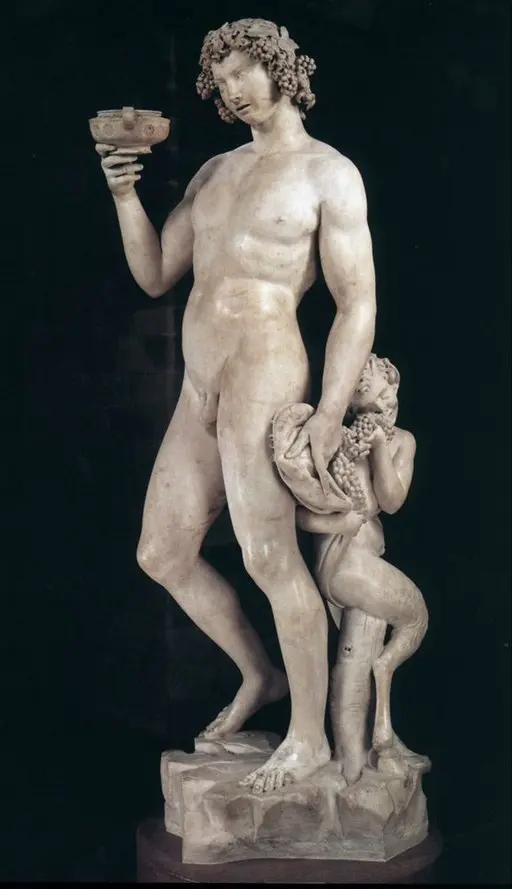
For a deeper look at early Michelangelo in Florence, the Bargello Museum is an underrated treasure that’s absolutely worth a visit—especially if you’re interested in sculpture and Michelangelo’s early work. One of the standout pieces here is Bacchus, his sculpture of the Roman god of wine. It’s a far cry from the powerful, larger-than-life figures he’d later become famous for. Instead, Bacchus feels young, loose, almost unsteady on his feet—like he’s had a bit too much to drink. There’s a playful, almost mischievous energy to it that gives you a glimpse of Michelangelo experimenting and finding his voice as an artist.
What makes Bacchus so compelling is how Michelangelo departs from the idealized forms of classical sculpture. Rather than focusing on the heroic, he captures the lighthearted, sensual side of life, showing the god not in a moment of grandeur but in a relaxed, almost indulgent posture. The way the body is portrayed—full of movement and life—is a testament to Michelangelo’s ability to infuse even a playful figure with the same emotional depth that he would later apply to more serious works.
The Bargello Museum also showcases other important works by Michelangelo, such as the Tondo Pitti, an unfinished piece that shows his early experimentation with form. The figures of the Virgin and Child in the Tondo Pitti seem to emerge from the marble, as though they are trapped in the stone, waiting to be fully realized. It’s a powerful example of Michelangelo’s working process. These unfinished works, in many ways, feel more alive than the polished masterpieces, offering a raw glimpse into the artist’s mind.
Uffizi Gallery: Michelangelo’s Contribution to Painting
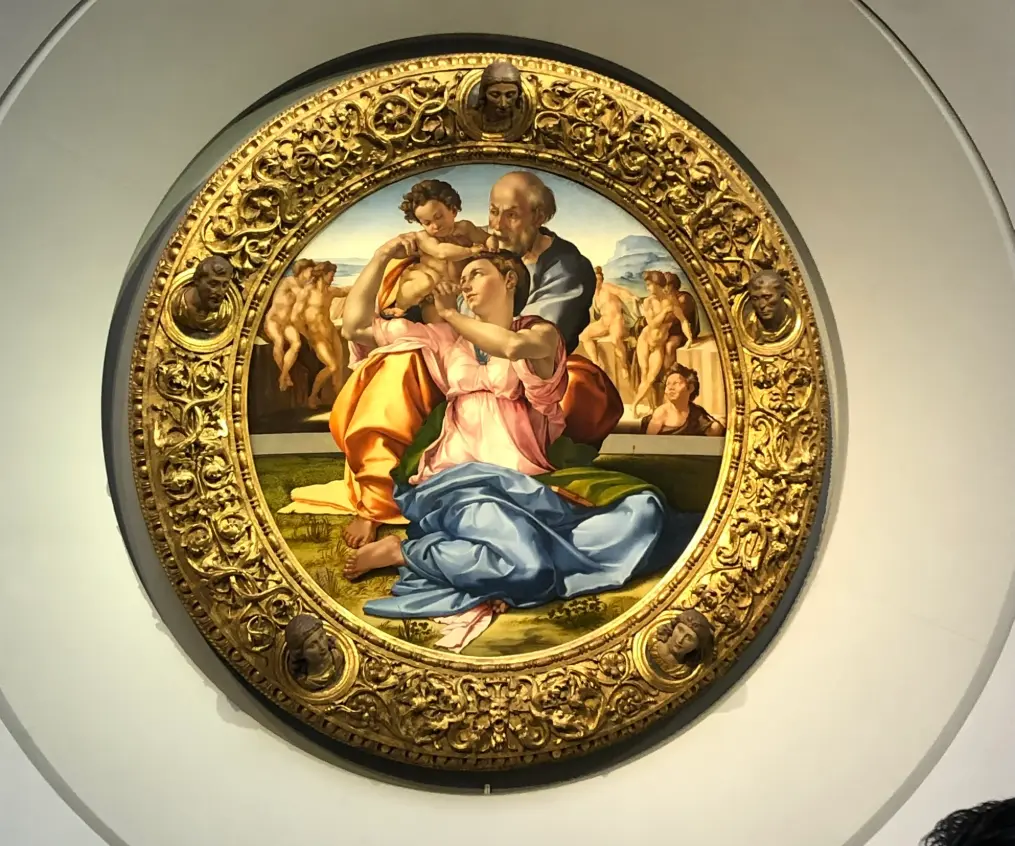
Although Michelangelo is celebrated for both his sculptures and paintings, his contributions to painting are just as groundbreaking. The Doni Tondo, housed in the Uffizi Gallery, is one of his few surviving painted works, and it’s an incredible example of how Michelangelo’s sculptural approach influenced his painting. The Doni Tondo depicts the Holy Family, but what makes it remarkable is how Michelangelo brings his figures to life in a way that seems sculptural rather than painted.
The figures in the Doni Tondo are full of volume and three-dimensionality, as though they could step off the canvas and into the room. What I love about this work is how Michelangelo’s use of light and shadow gives the figures a sense of solidity, almost as if they were carved from marble. The way he handles the composition, with figures spiraling around each other, creates a sense of dynamic energy, almost as if they’re caught mid-movement. It’s a beautiful example of Michelangelo’s ability to use painting to express the same ideas about form and anatomy that he used in his sculptures.
It is the only painting by Michelangelo housed in the Uffizi Gallery in Florence, which makes it a true treasure for anyone visiting the city.
Palazzo Vecchio’s Hidden Gem: Michelangelo’s Genius of Victory
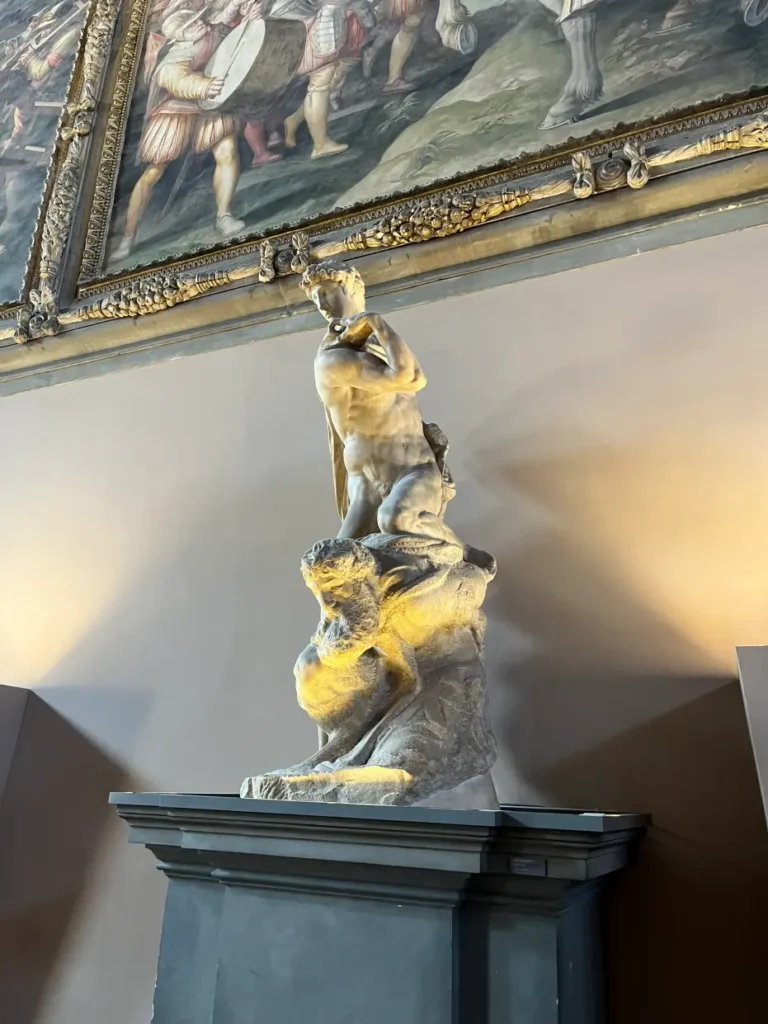
Hidden in plain sight inside the Palazzo Vecchio’s massive Salone dei Cinquecento, The Genius of Victory is one of those Michelangelo works that often gets overlooked—but it really shouldn’t be. Originally sculpted for the ambitious, never-completed tomb of Pope Julius II, this statue radiates confidence and complexity.
At first glance, you see a young, idealized figure standing in a graceful, twisting pose—his body full of movement, almost like he’s in mid-step. He represents Victory, not just in battle, but in spirit, intellect, and youth. What’s fascinating is how Michelangelo contrasts him with the figure beneath: an older, defeated man, carved in a rougher, less finished style. It’s not just a visual contrast, but an emotional one too—strength versus surrender, energy versus exhaustion. This play between polished and unfinished surfaces is classic Michelangelo. It almost feels like he’s letting you peek into his process—revealing both the refinement of his vision and the raw material it came from, side by side.
There’s also something unmistakably personal about the piece. Some art historians believe Michelangelo may have seen himself in both figures—the boldness of youth and the weariness of age, captured in a single block of stone. Art historian Edith Balas, in her book “Michelangelo’s Double Self-Portraits,” posits that the sculpture serves as a “double self-portrait.” She theorizes that Michelangelo identified with both the triumphant young victor and the subdued older captive, reflecting a personal dichotomy between youthful vigor and the burdens of age.
And where better to display such a powerful work than in the heart of Florence’s historic seat of power? It’s a quiet yet striking reminder of how deeply Michelangelo understood not just anatomy, but emotion, symbolism, and the human condition.
Michelangelo’s Final Resting Place: A Quiet Farewell
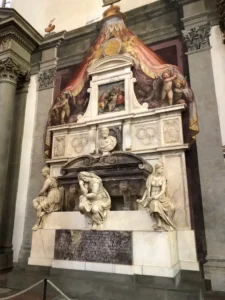
Visiting Santa Croce Church to see Michelangelo’s tomb offers a quiet, reflective close to any journey exploring Michelangelo in Florence. His tomb, designed by his pupil Giorgio Vasari, is simple yet dignified, reflecting Michelangelo’s own humility despite his towering achievements.
Standing before his tomb, I couldn’t help but think about how much Michelangelo gave to the world—not just as an artist, but as a thinker, innovator, and a symbol of the Renaissance spirit.
If you’re anything like me, seeing the art is one thing—but really understanding it is something else entirely. A guided tour can add just the right layer of insight and storytelling. Whether it’s the David, the Medici Chapels, or the Uffizi, check out these tours below if you feel like going a little deeper. No pressure—just a great option if you’re curious.
You may also like

